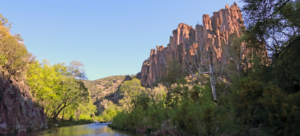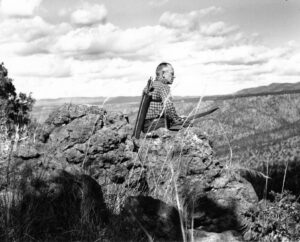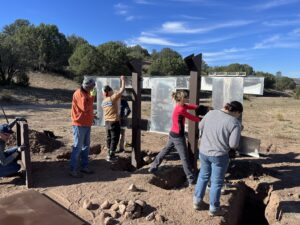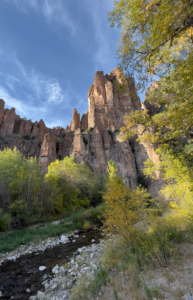
This year, we celebrate the centennial of the Gila Wilderness—the 100th anniversary of its initial administrative designation by the U.S. Forest Service.
In the early 1900s, forester and conservationist Aldo Leopold was employed by the Forest Service and worked in the Southwest. It was a time of great change for the American landscape, when, to the fledgling Forest Service, managing forests meant clearcutting, road building, fire suppression, predator extirpation, and introducing nonnative fish.

It was in this context that a young Leopold had the most radical idea of all: What if we let nature lead the way?
And so, in 1924, at the urging of Leopold and his allies, the Forest Service administratively designated the land surrounding the headwaters of the Gila River as the Gila Wilderness—the first such designation in the world. The Gila Wilderness became the model upon which the Wilderness Act was based.
Indeed, a full 40 years later, after continued commercial development of our public lands and the commensurate loss of vast tracts of wildlands and habitat, Congress passed the Wilderness Act of 1964. The act defines Wilderness as: “A wilderness, in contrast with those areas where man and his works dominate the landscape, is hereby recognized as an area where the earth and its community of life are untrammeled by man …”
The concept of “untrammeled” Wilderness is one in which ecological processes are allowed to play out without human intervention, a rare antidote to an increasingly human-dominated world and an acknowledgment that even the best of human intentions—for example the century-long emphasis by the Forest Service on fire suppression and the resulting unhealthy forests and new era of mega-fires that we are coping with—can have profoundly negative ecological consequences. Congress further defined Wilderness as undeveloped, affected primarily by the forces of nature and offering outstanding opportunities for solitude or primitive and unconfined types of recreation.
The Wilderness Act protects these special, wild places, and today, federally designated Wilderness is the most robust and permanent form of protection available for public lands in the United States. Wilderness is critical in preserving habitats and biodiversity in the context of the increasingly severe climate and associated mass extinction crises. Prohibitions on development and commercial activities in Wilderness also protect cultural resources and cultural landscapes, clean air and water, and dark night skies and offer visitors the opportunity to experience a sense of adventure, self-reflection, humility and awe.
Upon its passage, the Wilderness Act instantly established 53 Wildernesses in 13 states, totaling 9.1 million acres and including the Gila. Thanks to grassroots advocacy by communities across the country and subsequent acts of Congress, the National Wilderness Preservation System has since grown to 806 Wildernesses in 44 states plus Puerto Rico, totaling nearly 112 million acres. New Mexicans should be proud that our very own Gila Wilderness was the genesis of this groundbreaking conservation tool.

New Mexico Wild has been ringing in the Gila’s centennial in numerous ways:
- We’re installing trailhead kiosks and interpretive panels to educate the public about the history of Wilderness and the Gila’s unique values.
- Our Wilderness Rangers are engaging volunteers to steward the Gila Wilderness.
- We’ve been hosting events and engagements in communities all around the Wilderness to celebrate this exceptional occasion and to look ahead to future conservation needs in the area.
- We will continue our tireless work to permanently protect the Gila River, including sending a delegation of Tribal and community leaders to Washington, D.C., to speak with members of Congress about the importance of passing the M.H. Dutch Salmon Greater Gila Wild and Scenic Rivers Act—a response to ongoing and repeated threats to dam and divert the Gila River, which originates in the Gila Wilderness and is the last undammed mainstem river in New Mexico.
 We have Wilderness today thanks to Leopold’s foresight and vision and the efforts of the countless people who have stood up to advocate for it since 1924. Yet, our work is not done. Millions of acres of public land across the United States are eligible for protection as Wilderness, including in the Gila National Forest and on public lands across New Mexico, but remain at risk of being lost forever to development and other factors. To this day, Wilderness exemplifies the simple idea that humility, foresight and restraint are really all it takes to “manage” these powerful, mysterious and increasingly rare wild places. Indeed, the Gila remains one of the most substantially intact ecosystems in the continental United States.
We have Wilderness today thanks to Leopold’s foresight and vision and the efforts of the countless people who have stood up to advocate for it since 1924. Yet, our work is not done. Millions of acres of public land across the United States are eligible for protection as Wilderness, including in the Gila National Forest and on public lands across New Mexico, but remain at risk of being lost forever to development and other factors. To this day, Wilderness exemplifies the simple idea that humility, foresight and restraint are really all it takes to “manage” these powerful, mysterious and increasingly rare wild places. Indeed, the Gila remains one of the most substantially intact ecosystems in the continental United States.
So, in the centennial year of the Gila Wilderness, we are going to follow the lead of those who came before us and follow the lead of nature. And though we will continue to fight for new Wilderness designations, we will also use all the tools we have to ensure the permanent protection of our existing Wilderness Areas, the wild creatures that inhabit them and the wild rivers that run through them.
We will stand up for Wilderness, wildlife and water.
This article appeared in our Spring/Summer 2024 newsletter.

